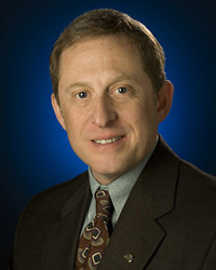Dr. S. Alan Stern
S. Alan Stern, Ph.D., FAAS, FIAA is principal investigator of the New Horizons mission to Pluto and the Chief Scientist at Moon Express.
Alan is a planetary scientist, space program executive, consultant, and author. He is serving as an Associate Vice President at the Southwest Research Institute and has his own aerospace consulting firm, with current and former clients including Jeff Bezos’s Blue Origin, Richard Branson’s Virgin Galactic, the Odyssey Moon Google Lunar X-Prize team, Boeing Aerospace, and the Johns Hopkins University.
In 2007 and 2008, Alan served as NASA’s chief of all space and Earth science programs, directing a $4.4B organization with 93 separate flight missions and a program of over 3,000 research grants. During his NASA tenure, a record 10 major new flight projects were started and deep reforms of NASA’s scientific research and the education and public outreach programs were put in place. His tenure also featured an emphasis on cost control in NASA flight missions that resulted in a 63% decrease in cost overruns. In 2007, he was named to the Time 100’s list of most influential people.
His career has taken him to numerous astronomical observatories, to the South Pole, and to the upper atmosphere aboard various high performance NASA aircraft including F/A-18 Hornets, KC-135 zero-G, and WB-57 Canberras. He has been involved as a researcher in 24 suborbital, orbital, and planetary space missions, including 9 for which he was the mission principle investigator; and he has led the development of 8 ultraviolet and visible/infrared scientific instruments for NASA space missions. Among his mission lead roles is NASA’s $720M New Horizon’s Pluto-Kuiper Belt mission, the largest PI-led space mission ever launched by NASA.
Prior to his service at NASA Headquarters in Washington, Alan served as the Executive Director of the Southwest Research Institute’s (SwRI’s) Space Science and Engineering Division from 2005–2007. Previous to that, from 1998 to 2005, he was the Director of the Space Studies Department at SwRI, and from 1994 to 1998, he was from 1994–1998 the leader of the Geophysical, Astrophysical, and Planetary Science section in SwRI’s Space Sciences Department. During his SwRI tenure from 1991 to 2007, Alan grew SwRI’s planetary group from three people to one of the largest in the world, with a total project value exceeding $250M.
Prior to founding SwRI’s Colorado operations in 1994, he was the leader of SwRI’s Astrophysical and Planetary Sciences group at Southwest Research Institute in San Antonio. From 1983 to 1991 he held positions at the University of Colorado in the Center for Space and Geosciences Policy, the office of the Vice President for Research, the Center for Astrophysics and Space Astronomy (CASA).
Before earning his doctorate from the University of Colorado in 1989, Alan completed twin master’s degrees in aerospace engineering and atmospheric sciences (1980 and 1981), and then spent six years as an aerospace systems engineer, concentrating on spacecraft and payload systems at the NASA Johnson Space Center, Martin Marietta Aerospace, and the Laboratory for Atmospheric and Space Physics at the University of Colorado. His two undergraduate degrees are in physics and astronomy from the University of Texas (1978 and 1980).
In 1995, Alan was selected to be a Space Shuttle mission specialist finalist, and in 1996 he was a candidate Space Shuttle Payload Specialist.
He has published over 200 technical papers and 40 popular articles. He has given over 300 technical talks and over 100 popular lectures and speeches about astronomy and the space program. He has written two books, The U.S. Space Program After Challenger (Franklin-Watts, 1987), and Pluto and Charon: Ice Worlds on the Ragged Edge of the Solar System (Wiley 1997, 2005). Additionally, he has served as editor on three technical volumes, and three collections of scientific popularizations: Our Worlds (Cambridge, 1998), Our Universe (Cambridge, 2000), and Worlds Beyond (Cambridge, 2003).
His research has focused on studies of our solar system’s Kuiper belt and Oort cloud, comets, the satellites of the outer planets, the Pluto system, and the search for evidence of solar systems around other stars. He has also worked on spacecraft rendezvous theory, terrestrial polar mesospheric clouds, galactic astrophysics, and studies of tenuous satellite atmospheres, including the atmosphere of the moon.
Alan has served on numerous NASA advisory committees, including the Lunar Exploration Science Working Group and the Discovery Program Science Working Group, the Solar System Exploration Subcommittee (SSES), the New Millennium Science Working Group, the Pluto Science Definition Team (SDT), and NASA’s Sounding Rocket Working Group. He was chairman of NASA’s Outer Planets Science Working Group from 1991 to 1994. He served as a panel member for the National Research Council’s 2003–2013 decadal survey on planetary science, and on the NASA Advisory Council (2006–2007). He is currently serving as the chair of the Suborbital Applications Researcher’s Group (SARG) of the Commercial Spaceflight Federation (CSF).
Alan is a fellow of the AAAS and the IAA, and a member of the AAS and the AGU; he was elected incoming chair of the AAS Division of Planetary Sciences in 2006.
He has been awarded the Von Braun Aerospace Achievement Award of the National Space Society, the 2007 University of Colorado George Norlin Distinguished Alumnus Award, and the 2009 St. Mark’s Preparatory School Distinguished Alumnus Award. He is a member of the board of directors of the Challenger Center for Space Science Education.
His personal interests include hiking, camping, and writing. He is an instrument-rated commercial pilot and flight instructor, with both powered and sailplane ratings. He and his wife Carole have two daughters and a son; they make their home near Boulder, Colorado.
Watch New Horizons: Exploring the Solar System’s Frontier, Origin of the Solar System with Dr. Alan Stern Part 1, and Origin of the Solar System with Dr. Alan Stern Part 2. Read Celebrate Suborbital, Congress and NASA: Expedite Commercial Crew, Imagine Reconnecting NASA, Creating Near-Term Results in US Human Space Exploration, A New Rocket for Science, and Apollo’s Greatest Achievement. Read his Wikipedia profile.
